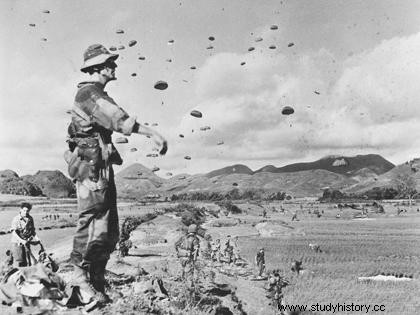
The French presence was maintained in Indochina during the war, but in 1945 the Japanese got rid of the last Europeans, both civilians and soldiers, who were executed or imprisoned. At the end of the hostilities, the Chinese Nationalists and the British took possession of the country, the Chinese occupying the north and the British the south. In 1945 General Leclerc had barely 40,000 men in Indochina, but these men were veterans of the war in Europe. When the French forces were deemed strong enough to maintain order, the British withdrew and the Chinese were persuaded to do the same.
According to Bernard B. Fall "the French forces sent to Indochina were too strong for France to resist the temptation to use them, but not strong enough to dissuade the Viet Minh from trying to solve the whole political problem by throwing the French into the sea... We can trace the origin of the Indochinese conflict to this simple, but tragic error of judgement.”
The shortage of means was to weigh on all French operations. Small-unit actions against identified objectives were generally successful, but there were not enough men available to apply the classic anti-guerrilla tactics of squaring and combing, or for long-range strategy. oil stain.
This strategy was based on the experience acquired by the French during the 19th century in North Africa. In the case of a hostile country, this technique consisted in ensuring a firm base and then, like a drop of oil which extends and unites with other drops, to spread to inside the territory by taking possession of the regions located between the bases. This process had worked well in Africa, where the terrain between the French forts was inhospitable, but in Indochina the hills and jungles provided plenty of cover and the villages shelter and supplies—that was "water." within which basked the "fish" of the guerrillas.
By grid, these hills and these jungles were divided into sectors which were then searched by combing. These tactics were originally used by Chinese Nationalists who had perfected sweeping into a sophisticated version of the cordon and search tactic. An area suspected of giving refuge to the Viet Minh was surrounded; the cord then moved closer to the center. When they met in the center, the troops would turn around and go back in the opposite direction to the outer edge of the area. In this way, we were trying to clean up the region. In practice, the local units of the Viet Minh could bury and hide themselves by the most ingenious means while the "regular" units, more important, had the possibility of slipping away as soon as the cord began to be put in place. place.
It was the desire to hasten the establishment of this cordon that prompted the French to use paratroopers, in the same way that the Americans were going to use helicopter troops in the during the second Indochinese conflict. It's a truism that parachuting soldiers into battle doesn't make them better fighters, rather it's training and selection that ensures quality. The parachute is a means to an end, and the French were to employ it in 150 major operations.
The denomination of buccaneer was specific to the Caribbean. They appeared around 1630 and lasted until the end of the piracy period around 1730. The first buccaneers were often escapees from the colonies. Originally coureurs de bois on the island of Hispaniola (present-day Santo Domingo and Haiti),
